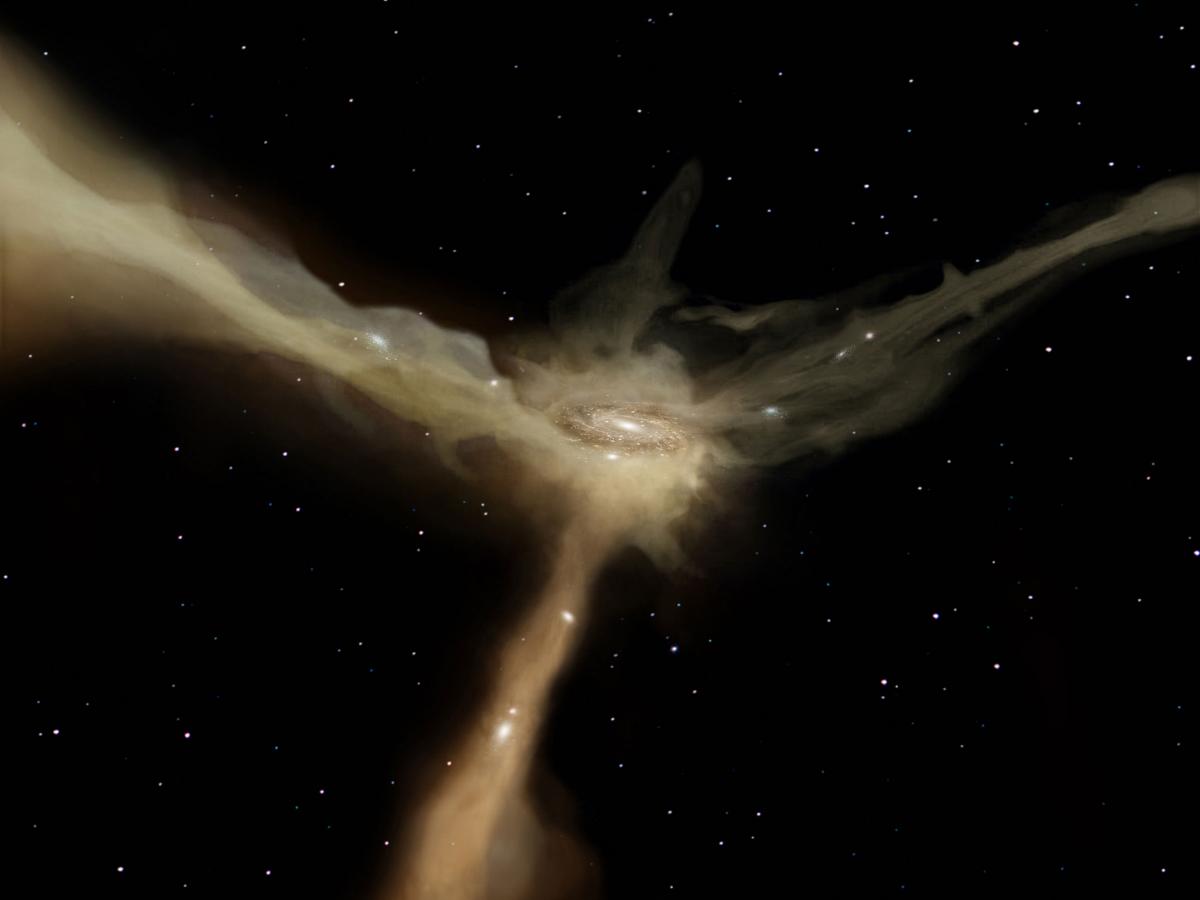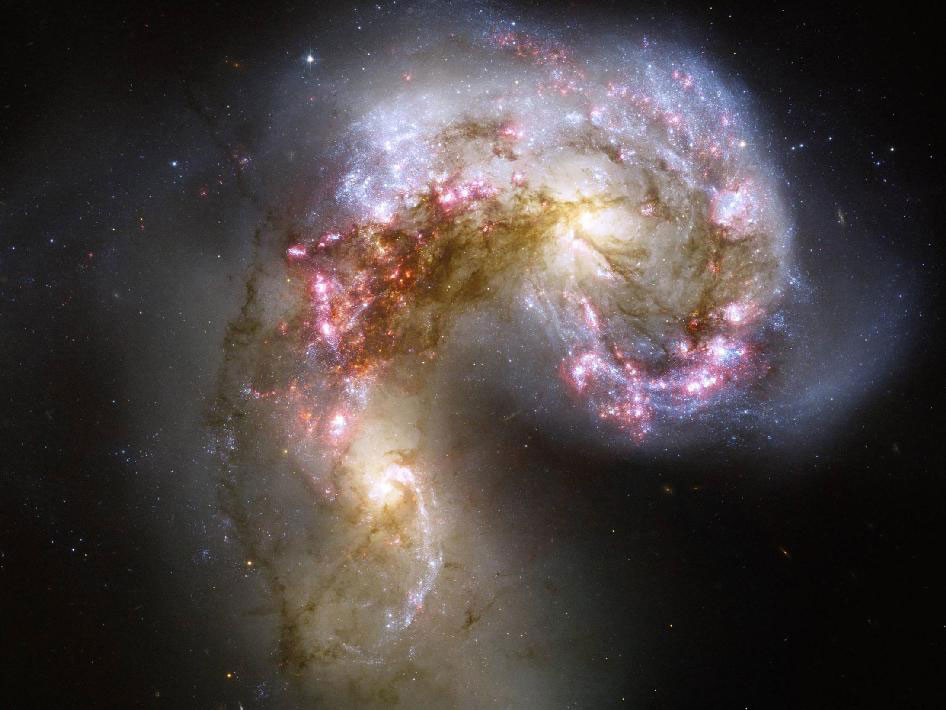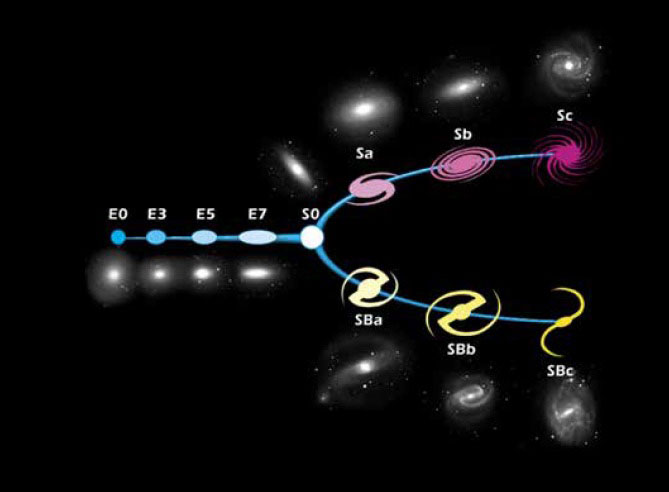Galaxies: genesis and evolution Understand article
Astronomers are still trying to discover exactly why galaxies formed in spiral shapes, and what’s likely to happen to our galaxy in the future.
The stillness of the night sky is as comforting as it is deceptive. Although it takes billions of years, the stars and galaxies that we see are in a constant state of evolution.
Thanks to increasingly sophisticated observational technology, astronomers can now see millions of galaxies at different distances from Earth: the light from what is thought to be the most distant galaxy observed so far has taken over thirteen billion (109) years to reach us (Zitrin et al., 2015). Working out the story of how galaxies change and evolve means looking back to the very earliest times in the Universe’s existence.

Image courtesy of ESA/AOES Medialab
The genesis of galaxies
Early in the history of the Universe, matter was distributed almost homogeneously through space with very small fluctuations in density of around just one part in 100 000 – like very, very tiny lumps of flour in an otherwise perfectly smooth sauce. But the Universe is now very far from homogeneous, with matter densely clustered into galaxies – so how did this change in the distribution of matter come about?
In fact, this question is linked to another mystery of the Universe: dark matter, what it is and what it is made of. Astronomers believe that most of the matter in the Universe is such ‘dark’ matter, rather than the ‘normal’ matter we see around us. Although all matter is drawn together by the attractive force of gravity, normal matter is also affected by forces that can push it apart, such as electromagnetic forces. This is not the case with dark matter, which – according to theory – is only affected by gravity. This means that any irregularity in dark matter will always attract more dark matter towards itself and grow, thus forming larger structures called dark matter ‘halos’. The gravitational pull of the massive dark matter halos eventually becomes strong enough to affect normal matter too, and so the cosmic production of galaxies can begin.
Initially, the normal matter dragged in by the dark matter will be a cloud of hydrogen gas. As the gas condenses to form stars, a proto-galaxy will begin to form, ultimately developing into a rotating disk – the typical form of a galaxy, like our own, the Milky Way. As the galaxy grows, the gas feedstock needs to be constantly replenished to sustain the stellar birth rate. Astronomers think that this hydrogen is obtained in the form of gas filaments drawn in from outside the galaxy. Observations of a distant galaxy ‘feeding’ on a nearby hydrogen cloud have confirmed this idea (Bouché et al., 2013).

Image courtesy of NASA, ESA, and the Hubble Heritage Team (STScI/AURA)-ESA/Hubble Collaboration
Galactic transformations
Galaxies can undergo spectacular changes during and after formation, due to the complex internal dynamics of stars, gas and the dark matter within them. For example, the striking spiral design of many galaxies is caused by internal gravitational processes: spiral arms are believed to arise from a density wave squeezing stars together as it propagates through the galaxy’s disk.
The central bar seen in many spiral galaxies, including the Milky Way, also results from such processes. The stars that form the central bar, seen in the spiral galaxy image here, are those that have deviated from their circular motion and started moving in increasingly elongated orbits. One possible explanation of this change is that in a rotating disk of stars, the inner stars complete a full circle faster that the outer ones, so they occasionally pass close to each other and ‘overtake’. This causes a perturbation of their circular orbits, which becomes amplified until a bar-like shape is createdw1.
Another important way in which a galaxy can be transformed is by merging with another galaxy. Sometimes a large galaxy will attract and engulf a smaller one in a kind of cosmic cannibalism. This may happen in our own galaxy in the future, if (as many scientists expect) it eventually swallows up the two nearby satellite galaxies known as the Magellanic Clouds, which are visible from the Southern Hemisphere.
Mergers also take place between galaxies of similar size, producing dramatic events that cause catastrophic changes in the galaxies’ properties. Such events leave behind a remnant galaxy that bears little resemblance to either of the original galaxies. As the Universe expands faster and faster, however, and galaxies move farther away from each other, the chance of galaxies merging is reduced.
The future of our galaxy
Today we are at a quiet stage in the Milky Way’s history, after the violent phases in which mergers of dark-matter halos and proto-galaxies caused the galaxy’s mass to increase substantially. For well over half of the history of the Universe, the main driver of our galaxy’s evolution has been internal dynamical processes. This will be the case for a couple more billion years. However, Andromeda, our closest similar galaxy (which appears to the eye as an insignificant star-like blob), moves 110 km closer to the Milky Way every second – and is set for a head-on collision with our galaxy in four billion years (Van der Marel et al., 2012). This major merger will take two billion years to complete, during which the identity of the two barred, spiral galaxies will be lost and a majestic elliptical remnant will be formed.

Image courtesy of Space Telescope Science Institute
Open questions
As a result of the enormous technical and scientific progress made in the field of galactic astronomy since the 1970s, we now understand a good deal about the ways that galaxies interact and change. Nonetheless, there are still many open questions. For example, as we look at galaxies farther and farther away, we see that many of them have different shapes than those nearby. We are observing these galaxies at an early stage of their existence, due to the billions of years that it takes for light to travel the vast distances. We know that these early, rather peculiar-shaped galaxies evolve over time into the more familiar elliptical or disk shapes, but we are not yet sure how this happens.
A central problem in galactic astronomy is the fact that we cannot actually observe astronomical processes in action, due to their extraordinarily long timescales. Instead, our understanding comes from building computational models and simulations based on theoretical models combined with observational data. To date, our best simulations do not completely match observed facts. For example, current simulations predict more red dwarf galaxies than we actually see. This discrepancy is a problem, as it suggests that there is something not quite right about the astronomical theories that were used to develop the simulation – but we are still unclear about where exactly the defects lie. Even the properties of our own galactic neighbourhood are at odds with some very fundamental numerical results: our satellite galaxies are too ‘fluffy’, or diffuse – and possibly too few – compared to the predictions of the most widely accepted cosmological scenariow2.
In recent decades, however, astronomical simulations have become much more accurate, and we are now able to model the movement of up to a trillion (1012) particles, in contrast to the few hundred particles in early simulations. This reduces the need for approximations, providing scope for much more accurate modelling of astronomical processes, which in turn enables us to understand those processes better theoretically. New observations and discoveries using the most advanced observation tools will also add greater accuracy, as well as new constraints, helping to reveal the flaws in our models.
In fact, the observation tools now coming into use may revolutionise our view of the cosmos. The Atacama Large Millimeter/Submillimeter Array, the largest astronomical project ever realised, and the James Webb Space Telescope, due to launch in 2018, will peer into dense clouds of gas and dust to elucidate the mystery of star formation. They will also be able to spot proto-galaxies that were forming when the Universe was less than five per cent of its current age, thereby adding significantly to our knowledge about the formation of galaxies.

Image courtesy of ALMA (ESO/NAOJ/NRAO)/L. Calçada (ESO)
References
- Bouché N, Murphy MT, Kacprzak GG et al. (2013) Signatures of Cool Gas Fueling a Star-Forming Galaxy at Redshift 2.3. Science 341: 50–53. doi: 10.1126/science.1234209
- Van der Marel RP, Besla G, Cox TJ, Sohn ST, Anderson J (2012) The M31 Velocity Vector. III. Future Milky Way M31-M33 Orbital Evolution, Merging, and Fate of the Sun. Astrophysical Journal 753: 9. doi: 10.1088/0004-637X/753/1/9
- Zitrin A, Labbe I, Belli S et al. (2015) Lyman-alpha Emission from a Luminous z = 8.68 Galaxy: Implications for Galaxies as Tracers of Cosmic Reionization. Astrophysical Journal of Letters 810: L12. doi: 10.1088/2041-8205/810/1/L12
Web References
- w1 – NASA has more information about barred spiral galaxies and galaxy evolution on its Hubble website.
- w2 – The Preposterous Universe blog takes a more in-depth look at diffuse galaxies.
Resources
- To learn more about dark matter, see:
- Boffin H (2008) Intelligence is of secondary importance in research. Science in School 10: 14.
- Warmbein B (2007) Making dark matter a little brighter. Science in School 5: 78-80.
- To learn more about the birth and evolution of stars, see:
- Boffin H, Pierce-Price D (2007) Fusion in the Universe: we are all stardust. Science in School 4: 61.
- Lopes A, Boffin H (2009) The first light in the Universe. Science in School 13: 48.
- Rebusco P, Boffin H, Pierce-Price D (2007) Fusion in the Universe: where your jewellery comes from. Science in School 5: 52.
- Watch this video, one of the many wonderful simulations of galaxy formation that you can find online.
- Learn more about the collision between the Milky Way and Andromeda using spectacular visualisations and a simulation movie of the event.
- To find out more about the Atacama Large Millimeter/Submillimeter Array Observatory, see:
- www.almaobservatory.org
- Mignone C, Pierce-Price D (2010) The ALMA Observatory: the sky is only one step away. Science in School 15: 44-49.
- Click here to find out more about the James Webb Space Telescope.
- Discover the Illustris Project, a very ambitious simulation project providing results of unprecedented quality on the cosmological evolution of dark matter and galaxies.
- Don’t miss your chance to become a citizen scientist! Help astronomers to classify galaxies by signing up to the Galaxy Zoo project.
Institutions
Review
This article, which explains the genesis and evolution of galaxies, could be used to deepen students’ knowledge about the Universe.
Before reading the text, students could be asked the following questions to start them thinking about the concepts explained in the article:
- What is our galaxy’s name?
- Do all galaxies have the same shape and size?
- How do you think galaxies are formed?
- What can make a galaxy evolve?
Finally, the article could be used as a starting point for discussing the importance of the development of observational tools to improve our view of the cosmos. Students have to be aware that, in science, accepted theories are the best explanations available at a certain moment. However, if new evidence is encountered that does not match existing theories, it may be necessary to reformulate them.
Mireia Güell Serra, Spain





